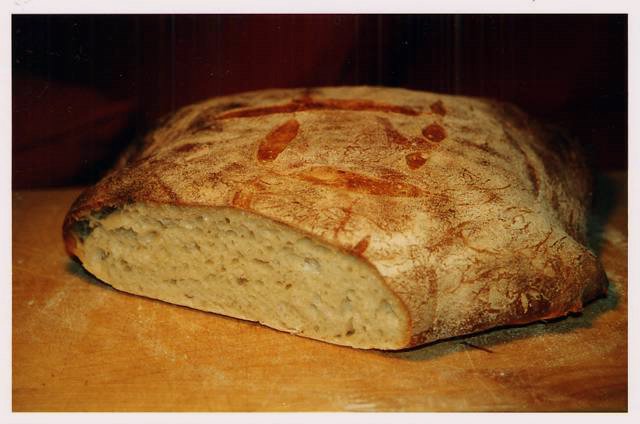On self-sufficiency and sourdough
Forget the Ann Demeulemeester sex bag and all that snooty France stuff; give me a bull-scrotum bag and the open prairie, land of my birth. Forget the joys of a shower with excellent water pressure; all I need is the Red River and some pumice. Cast off the lacy lingerie and other things requiring delicate hand-washing; give me leather, rags, and a splintery washboard. And down with Mr. Pete, my trusty four-wheeled steed; I want Cinnabar, that wild-maned, dead-legged beast we fought over at summer camp.
Dear reader, I’m trying my hand at being a self-sufficient pioneer woman, able to sustain herself, sweaty man, and grubby kids on nothing more than flour, salt, and water. How convenient that some flours are fortified with vitamin C; that way, we won’t get scurvy. Modern pioneer life is something indeed.
This tale begins October 29, 2004 with Margot’s sourdough starter, which for weeks I’d been lovingly stirring, feeding, sniffing, and stroking. Being of the “anything with wheat must be tastier and is of course infinitely more nutritious” school, I chose as my first project a simple whole wheat bread from Sourdough Jack’s Cookery. For brevity’s sake, I summarize: all went well until I moved the three loaves from their nice warm rising spot into the oven, whereupon they collapsed and withered. I’d asked my sourdough to work harder than it was prepared to. The resulting loaves, while a lovely shade of gold, were rather diminutive, measuring between two and three inches tall. This disappointing fact, however, did not stop me from consuming a third of one loaf immediately. The rest was quite passable when toasted, especially when lacquered with a bit of this summer’s strawberry jam. I made do. After years on the frontier, I’m used to disappointment.
Undaunted by the previous weekend’s mediocre showing, I set out on November 6 with Jack Lang’s excellent tutorial on sourdough. Starter is nothing short of magic: it bubbles and fizzes, weaving elastic strands of gluten that look not unlike Halloween’s leftover decorative cobwebs. I was uncertain of how much flour to add during the final shaping stages, and the dough was sticky and stretchy and belligerent. But my banneton (a fortuitous purchase at BHV) coddled it gently through the night, and aside from a bit of sticking upon transfer from “peel” (a.k.a. cookie sheet) to “baking stone” (a.k.a. aluminum half-sheet), the process went reasonably well.
Being an exacting sort of pioneer woman, I was of course expecting Poilâne quality on the first try. Opening the oven, however, I was met with a fairly flat, amoeba-shaped loaf. I dismissively chucked it onto a cooling rack and slunk off to the river for a good cleansing. But, dear, patient reader, when it was thoroughly cooled, I cut off a good chunk and found it shot through with beautiful little air holes and pockets, off-white, giving off a slight sheen under the light.

The crust was thin but crispy, the crumb delicate, chewy, and almost sweet. It might not be perfect, but it will make a quite satisfactory lunchtime vehicle for a swipe of peanut butter. It takes little to please a pioneer woman.
This tale of self-sufficiency has only just begun. The starter lives on, and plans are in the works for another go with Mr. Lang’s method next weekend. Perhaps the holidays will bring Nancy Silverton’s Breads from the La Brea Bakery. That, and a KitchenAid mixer with a dough hook. I’m desperate for a dough hook; it’s so rough-and-tumble, so pointy and untamed. This guy is much funnier than I am, and he’s got pretty bread; I attribute it to the dough hook and gobs of large Tupperware. All that stands between me and a KitchenAid mixer is my mother, who keeps hers—a second-hand find of my father’s that she’s never used; oh, the waste!—on the pantry floor, surrounded by mouse traps, old dog bowls, and rolls of paper towels. Look out, Oklahoma: come Thanksgiving, your mixer is mine. If it’s from Oklahoma, it must be authentically pioneer-esque, like me.

